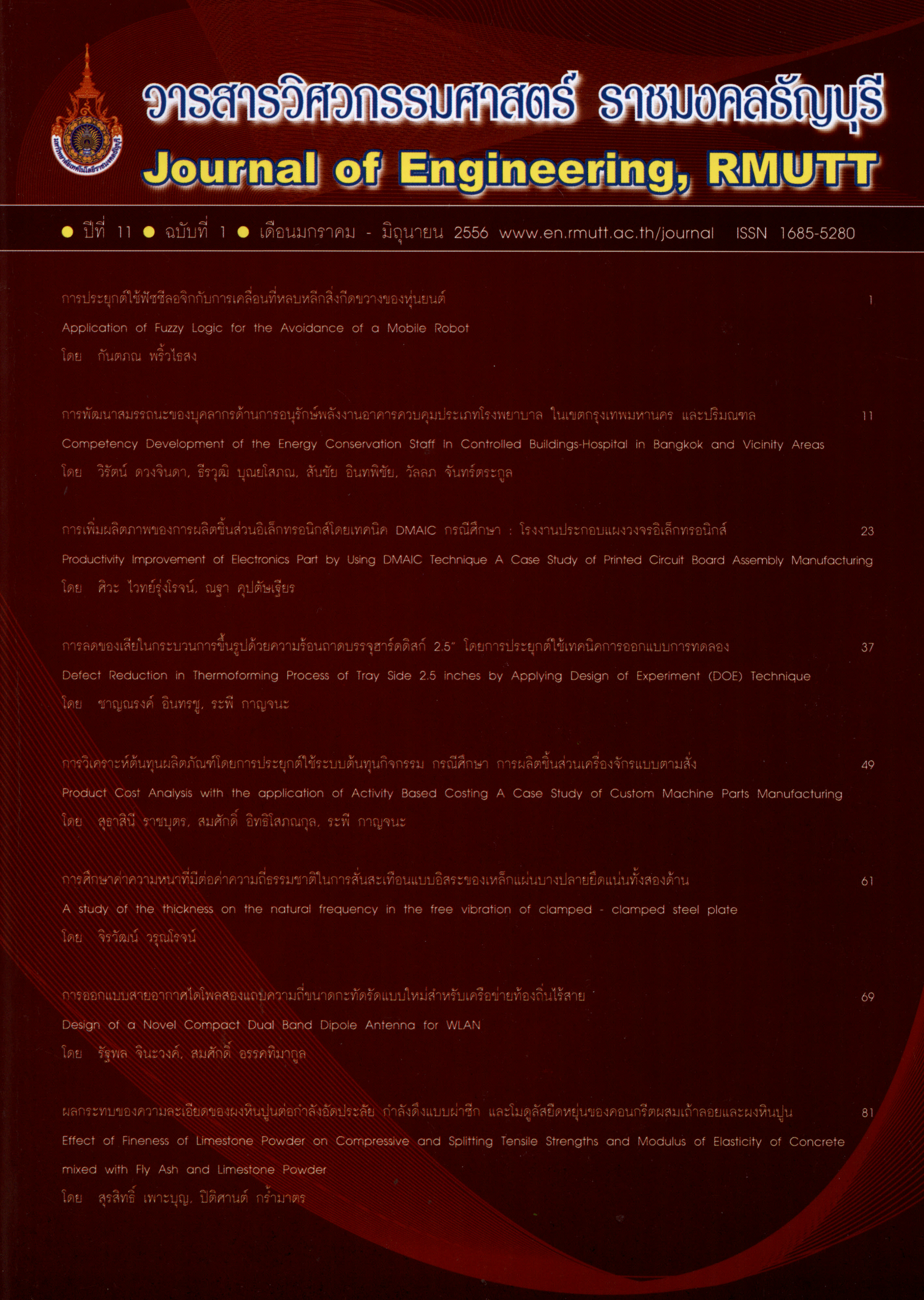Effect of Fineness of Limestone Powder on Compressive and Splitting Tensile Strengths and Modulus of Elasticity of Concrete mixed with Fly Ash and Limestone Powder
Main Article Content
Abstract
This paper presents the study results of the effect of fineness of limestone powder on the mechanical properties of concrete mixed with fly ash and limestone powder. Limestone powder with
haring fineness by representing as a mean particle size (d ) equal to 2, 8 and 15 micrometers (um) was aken into account by replacing in Type 1 Portland cement of the replacement percentage of 0%,5%,10% and 20% by weight and blended with fly ash at replacement percentage of 30%, 25%, 20% and 10% by weight. The basic properties of all materials which are chemical composition,physical including specific gravity and Blaine fineness were investigated. Mechanical properties which are the compressive and splitting tensile strengths and modulus of elasticity were tested. Results show that the compressive strengths of early-age concrete containing limestone powder have higher tendency than those of conventional concretes. In addition, the limestone powder-fly ash concretes have also high compressive strength than those of conventional concretes. Furthermore, the splitting tensile modulus of elasticity of concrete containing fly ash and limestone powder have a similar heirs compressive strength. In summary, the fineness of limestone powder has higher mechanical properties, which has higher fineness limestone powder has higher mechanical proper lower one.
Article Details
The manuscript, information, content, picture and so forth which were published on Frontiers in engineering innovation research has been a copyright of this journal only. There is not allow anyone or any organize to duplicate all content or some document for unethical publication.
References
ชัย จตุรพิทักษ์กุล และ วีรชาติ ตั้งจิรภัทร, 2552.ปูนซีมนต์ ปอซโซถาน และคอนกรีต, พิมพ์ครั้งที่ 2, ภาควิชาวิศวกรรมโยธา คณะวิศวกรรมศาสตร์ มหาวิทยาลัยเทคโนโลยีพระจอมเกล้าธนบุรี
คณะอนุกรรมการคอนกรีตและวัสดุ ภายใต้คณะกรรมการวิชาการสาขาวิศวกรรมโยธาวิศวกรรมสถานแห่งประเทศไทยในพระบรมราชูปถัมภ์, 2543. ความคงทนของคอนกรีต,พิมพ์ครั้งที่ 1
ปีติศานต์ กร้ำมาตร และสมนึก ตั้งเติมสิริกุล, 2550.การต้านทานซัลเฟตของตัวอย่างมอร์ต้าร์ฝุ่นหินปูน,การประชุมวิชาการคอนกรีตประจำปี ครั้งที่ 3,24-26 ตุลาคม 2550, ชลบุรี.
N. Voglisa, G. Kakalia, E. Chaniotakisb, S.Tsivilisa, 2005. Portland-limestone cement. Their properties and hydration compared to those of other composite cements, Cement & Concrete Composites, Vol. 27, pp. 191-196.
จตุพร ชูตาภา และ วรพจน์ แสงราม, 2552.แคลเซี่ยมคาร์บอเนต (Calcium Carbonate:CaCo3 ), วิหารแดง, ปีที่ 1, ฉบับที่ 6 มิถุนายน.
Neville, A.M., 1981. Properties of Concrete.Pittmen Book Limited, London.
D. P. Bentz, Taijiro Sato, Igor de la Varga,W. Jason Weiss, 2012. Fine limestone additions to regulate setting in high volume fly ash mixtures, Cement & Concrete Composites, Vol. 34, Pp.11-17.
สำนักงานมาตรฐานผลิตภัณฑ์อุตสาหกรรม กระทรวงอุตสาหกรรม, 2547. มาตรฐานผลิตภัณฑ์อุตสาหกรรม มอก. 15 เล่ม 1.
American Society for Testing and Materials.2012. ASTM C39 / C39M - 12a Standard Test Method for Compressive Strength of Cylindrical Concrete Specimens, Annual book of ASTM standards vol.04.02,Philadelphia, USA: American Society forTesting and Materials.
American Society for Testing and Materials,2011. ASTM C496 / C496M - 11 Standard Test Method for Splitting Tensile Strength of Cylindrical Concrete Specimens, Annual book of ASTM standards vol.04.02, Philadelphia, USA:American Society for Testing and Materials.
American Society for Testing and Materials,2010. ASTM C469 / C469M - 10 Standard Test Method for Static Modulus of Elasticity and Poisson's Ratio of Concrete in Compression, Annual book of ASTM standards vol.04.02, Philadelphia, USA: American Society for Testing and Materials.


